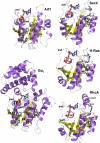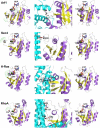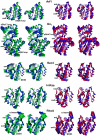Nucleotide binding switches the information flow in ras GTPases
- PMID: 21390270
- PMCID: PMC3048383
- DOI: 10.1371/journal.pcbi.1001098
Nucleotide binding switches the information flow in ras GTPases
Abstract
The Ras superfamily comprises many guanine nucleotide-binding proteins (G proteins) that are essential to intracellular signal transduction. The guanine nucleotide-dependent intrinsic flexibility patterns of five G proteins were investigated in atomic detail through Molecular Dynamics simulations of the GDP- and GTP-bound states (S(GDP) and S(GTP), respectively). For all the considered systems, the intrinsic flexibility of S(GDP) was higher than that of S(GTP), suggesting that Guanine Exchange Factor (GEF) recognition and nucleotide switch require higher amplitude motions than effector recognition or GTP hydrolysis. Functional mode, dynamic domain, and interaction energy correlation analyses highlighted significant differences in the dynamics of small G proteins and Gα proteins, especially in the inactive state. Indeed, S(GDP) of Gα(t), is characterized by a more extensive energy coupling between nucleotide binding site and distal regions involved in GEF recognition compared to small G proteins, which attenuates in the active state. Moreover, mechanically distinct domains implicated in nucleotide switch could be detected in the presence of GDP but not in the presence of GTP. Finally, in small G proteins, functional modes are more detectable in the inactive state than in the active one and involve changes in solvent exposure of two highly conserved amino acids in switches I and II involved in GEF recognition. The average solvent exposure of these amino acids correlates in turn with the rate of GDP release, suggesting for them either direct or indirect roles in the process of nucleotide switch. Collectively, nucleotide binding changes the information flow through the conserved Ras-like domain, where GDP enhances the flexibility of mechanically distinct portions involved in nucleotide switch, and favors long distance allosteric communication (in Gα proteins), compared to GTP.
Conflict of interest statement
The authors have declared that no competing interests exist.
Figures










References
Publication types
MeSH terms
Substances
Grants and funding
LinkOut - more resources
Full Text Sources

